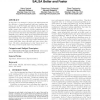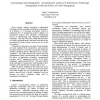499 search results - page 27 / 100 » Why neighbor-joining works |
WSDM
2009
ACM
14 years 4 months ago
2009
ACM
In this paper, we attempt to improve the effectiveness and the efficiency of query-dependent link-based ranking algorithms such as HITS, MAX and SALSA. All these ranking algorith...
HICSS
2003
IEEE
14 years 3 months ago
2003
IEEE
Given societies’ massive investment in information technology and the potentially catastrophic consequences of IT failures, it is becoming increasingly critical to understand ho...
AAAI
1998
13 years 11 months ago
1998
The "minimum margin" of an ensemble classifier on a given training set is, roughly speaking, the smallest vote it gives to any correct training label. Recent work has sh...
Publication
Ever wondered why open source finally yields products that work? Eric Raymod discusses that in this paper using the bazaar as a metaphor for open source hacker developed software t...
ADAEUROPE
2008
Springer
14 years 4 months ago
2008
Springer
The Cheddar project deals with real time scheduling theory. Many industrial projects do not perform performance analysis with real time scheduling theory even if the demand for the...


